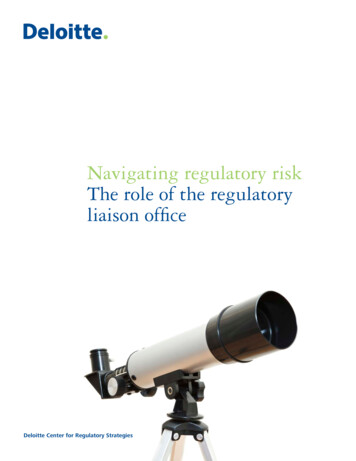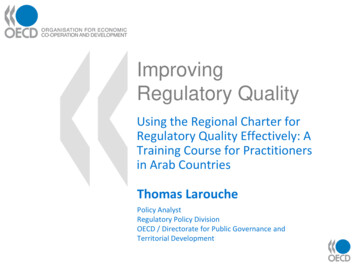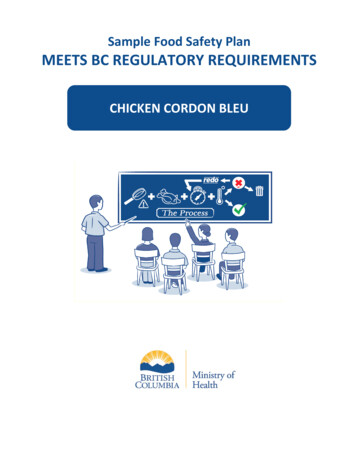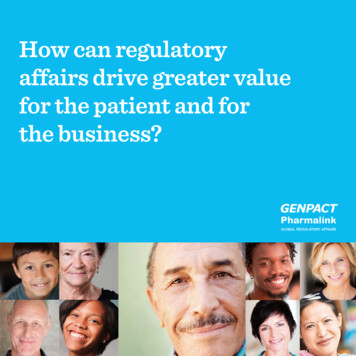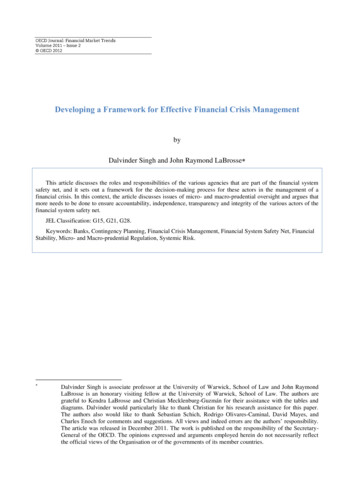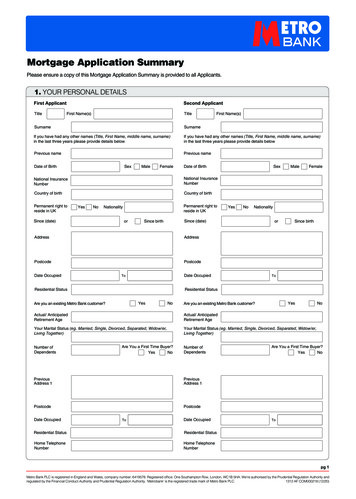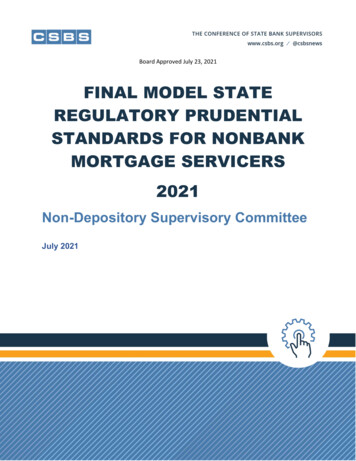
Transcription
Board Approved July 23, 2021FINAL MODEL STATEREGULATORY PRUDENTIALSTANDARDS FOR NONBANKMORTGAGE SERVICERS2021Non-Depository Supervisory CommitteeJuly 2021
SummaryOn October 1, 2020, the Conference of State Bank Supervisors (CSBS), at the direction of theCSBS Board of Directors and under the auspices of the CSBS Non-Depository SupervisoryCommittee (NDSC), released a proposal for public consideration entitled Proposed RegulatoryPrudential Standards for Nonbank Mortgage Servicers (“Proposal” or “Proposed Standards”).The Proposal was based on state regulators’ determination that a sound financial condition andsafe management practices are essential to compliance and consumer protection. The Proposalsought to establish state regulator requirements and expectations not only for legal compliancebut also for safe and sound operations.Following the NDSC’s review of public comments and further consideration, including revisionsto the Proposal, the CSBS Board issues these Final Model State Regulatory Prudential Standardsfor Nonbank Mortgage Servicers (“Final Model Standards”) as uniform state policy for thesupervision of nonbank mortgage servicers meeting specific coverage requirements. Asdiscussed herein, this policy is intended as a model for voluntary adoption by each state asdeemed appropriate and necessary. Nothing in this policy establishes legal requirements, andthe policy itself does not constitute law, regulation, official guidance, or interpretation of anystate agency that has not taken affirmative action to incorporate these standards as such.Issuance and Publication Dates – ImplementationCSBS issued its Proposal on October 1, 2020, with a public comment period running throughDecember 31, 2020. The Final Model Standards were approved as uniform state policy on July23, 2021.As discussed under CSBS Policy (pg 14), the requirements contained in this policy are onlyeffective through state implementation. State agencies may use this policy to formulate law,rule, guidance or procedure under their individual jurisdictional authority or legislative process.Contact InformationQuestions regarding CSBS policy, or the Final Model Standards may be submitted to ChuckCross, CSBS Senior Vice President Nonbank Supervision and Enforcement at ccross@csbs.org.Additional or updated information may be found at cers.Summary of Final RuleThe Final Model Standards cover two major categories that comprise prudential standards:financial condition and corporate governance. To the extent practical, the Final ModelStandards align with existing standards or leverage generally accepted business practices. TheseFinal Model Standards represent model regulatory requirements for state-licensed nonbank2Proposed Prudential Standards for Nonbank Mortgage Servicers 2021
mortgage servicing firms that exceed the de minimis cutoff discussed under Coverage –Exceptions – Qualifiers (pg. 3). Details of the Final Model Standards can be found under theSection-by-Section Analysis (pg. 14). Codification of the requirements of the Final ModelStandards can be found under Codification of Requirements for State Adoption – Model Law orRule (pg. 24).Coverage – Exceptions – QualifiersThe nonbank mortgage servicing industry is diverse, ranging from small firms withstraightforward operations to large, complex institutions and asset managers with multiplebusiness lines. By employing a de minimis coverage trigger and existing standards or generallyaccepted business practices, the Final Model Standards minimize regulatory burden for small,less complex servicing firms while establishing uniformity and standardization for the industry.In general, the Final Model Standards are intended for state licensed or supervised nonbankmortgage servicers and investors in mortgage servicing, with certain exclusions, exceptions andqualifiers identified below:Coverage: These standards apply to nonbank mortgage servicers with portfolios of 2,000 ormore 1 – 4-unit residential mortgage loans serviced or subserviced for others and operating intwo or more states 1 as of the most recent calendar year end, reported in the NationwideMultistate Licensing System (NMLS) Mortgage Call Report. 2 For purposes of determiningcoverage under these Final Model Standards, “residential mortgage loans serviced” excludeswhole loans owned and loans being “interim” serviced prior to sale.Applicability: The Final Model Standards apply to all nonbank mortgage servicers meeting thecoverage requirements.Exclusions:a) The financial condition requirements in these Final Model Standards do not apply toservicers solely owning and/or conducting reverse mortgage servicing or the reversemortgage portfolio administered by forward mortgage servicers that may otherwise becovered under these standards. Although state regulators identify risk in this type ofspecialty servicing, the reverse servicing business model is unique, with differentstructures and control needs and therefore has been excluded from the financialrequirements.b) These standards do not apply to not-for-profit mortgage servicers or housing financeDefined as Covered Institutions in the Model Law, see Codification of Requirements for State Adoption – Model Law or Rule –Sec. 100 Definitions (pg. 24).2 The NMLS Mortgage Call Report is a quarterly report of residential real estate loan origination, servicing and financialinformation completed by companies licensed in NMLS. For more information, visit the NMLS Resource Center, available slr/common/mcr/Pages/default.aspx13Proposed Prudential Standards for Nonbank Mortgage Servicers 2021
agencies.Exceptions:a) The capital and liquidity requirements of the Final Model Standards have limitedapplication to entities that only perform subservicing for others.b) The capital and liquidity requirements of the Final Model Standards do not include thewhole loan portion of portfolios in the calculations of those respective requirements.Qualifiers:a) Standards as Policy: These Final Model Standards are established as CSBS policy and donot constitute law, regulation, official guidance or interpretation of any state agencythat has not taken affirmative action to incorporate these Final Model Standards assuch. State regulators and state legislatures are responsible for determining theapplicability of these Final Model Standards under their respective jurisdictions. Stateregulators should consider these Final Model Standards models for statutoryamendments or regulations under existing supervisory authority.b) No Intent to Prohibit Coverage for Single State Servicers: These model standards are notintended to limit or prohibit an individual state from determining that all or a portion ofthese standards are applicable to servicers not meeting the minimum coverage trigger.Such determinations are limited to single state jurisdiction and do not affect theuniformity of these standards as a national model.c) In some situations, a servicer may meet the coverage triggers while servicing negligibleamounts of loans in a particular state. Determination of coverage in a low volume statecan only be made by that individual state. The NDSC encourages commissioners toindependently consider the impacts of added regulatory burden in situations whereservicing volume is negligible. [Note: Sec. 500 of the Model Law (pg. 29) providescommissioner flexibility for unique circumstances.]d) Mortgage Servicing Rights (MSR) Investors: A MSR investor subject to licensing as aservicer in any state is considered a servicer.e) Applicable to Licensed Entity: These standards apply to the servicer or state licensedentity level within a holding company or affiliated group of companies.f) Supervisory Authority Reserved: The Final Model Standards as policy does not control oralter state authority to supervise nonbank mortgage servicers. State agencies exercisestatutory authority to protect consumers and regulate industry and the local market.While this policy sets forth standards and controls intended to foster uniformity at thenational level, CSBS and its state members respect and reserve each state’s sovereignjurisdiction, authority, and responsibility.4Proposed Prudential Standards for Nonbank Mortgage Servicers 2021
BackgroundNonbank mortgage servicers are an important segment of the financial services community.These institutions currently service 60% of the agency mortgage market 3 and roughly 45% ofthe total 11 trillion single-family residential mortgage market.4 As the institutions responsiblefor transmitting monthly borrower payments to investors or loan holders, mortgage servicersare an integral part of the mortgage market ecosystem.A servicer is the company responsible for the administration of the loan beginning immediatelyafter closing and continuing until the loan is paid off and the lender’s security interest in theproperty is released or cancelled. A servicer is responsible for collecting borrower paymentsincluding principal, interest, taxes, and insurance, then remitting or forwarding those paymentsto investors, taxing authorities or insurance providers. 5 If a borrower is delinquent onpayments, the responsibility falls to the servicer to do everything it can to collect the paymentand any late fees or penalties authorized under the original loan contract. Servicers areresponsible for managing loss mitigation and borrower forbearance of payments and initiatingforeclosure proceedings when a borrower reaches a certain stage of delinquency. 6 Servicersalso manage a variety of administrative responsibilities including accounting, record keeping,investor reporting and advancing unpaid amounts to investors, taxing authorities and insuranceproviders.Without servicing, the mortgage market in the United States as currently structured wouldcease to function. Servicers occupy the space between the consumer and the loan holder orinvestor. This creates an obligation to both parties of the transaction, making servicerssimultaneously responsible for efficiently servicing the market and protecting consumers.The role of a servicer is controlled by borrower protections established by law on the side of theconsumer and by contract and investor protections on the side of the beneficial owner of themortgage-backed security (MBS). Between these two legal anchors, management is responsiblefor operating the institution in a safe and sound manner. The core of these standards is focusedon that responsibility.Nonbank entities that specialize in loan servicing have grown dramatically in size, complexity,and importance in the post-financial crisis mortgage market. Nonbank mortgage servicers andThe “Agency” mortgage market includes mortgage loans purchased or securitized by Fannie Mae or Freddie Mac (also knownas Government Sponsored Enterprises, or GSEs) and loans made, insured or guaranteed by the U.S. Departments of Housingand Urban Development, Veterans Affairs or Agriculture (together known as Ginnie Mae guaranty mortgage loans).4 All loans, Agency plus privately made mortgage loans.5 Note that servicers hold tax and insurance payments in escrow for borrowers for months until payment is due, creatingadditional responsibilities for holding and accounting for other people’s money.6 The Covid-19 pandemic resulted in the CARES Act, federal legislation that enabled greater use of payment forbearanceprovisions while temporarily changing the reporting of delinquencies and placing moratoriums on foreclosures. Theseprudential standards, while originally proposed during the pandemic, were not developed to address the pandemic or theCARES Act provisions.35Proposed Prudential Standards for Nonbank Mortgage Servicers 2021
asset managers acquired massive portfolios of mortgage servicing rights after 2011, many ofwhich initially consisted of delinquent loans that required specialized skill in high-touchservicing. As the volume of delinquent loans sold by depositories following the crisis trailed offand more loans resolved, this market niche consolidated, and the trading of MSRs evolved tofocus on newer production and servicing of GSE and government-backed loans often in Agencysponsored MBS.Changes in the mortgage market and nonbank servicer rapid growth have highlighted thecritical services these institutions provide to homeowners, investors, and other marketparticipants. A more detailed discussion of the nonbank mortgage origination and servicingmarkets, including a description of servicer business model and risk can be found in the CSBSwhite paper series entitled Reengineering Nonbank Supervision, found at www.CSBS.org.Nonbank Mortgage Servicing AdministrationMortgage loan servicing is a critical component of the broader housing finance system. Loanadministration by nonbank mortgage servicing companies include the following responsibilitiesand servicing functions: Calculating, collecting, recording and remitting a mortgage loan borrower’s principal,interest, taxes, insurance or other paymentsMaintaining accurate account records and customer billing statements.Managing mortgage escrow accounts (taxes, insurance, etc.)Providing accurate investor reportingCollecting and managing insurance claimsDistributing, tracking, and financing servicing advancesManaging delinquent and defaulted mortgage loans, as well as those in bankruptcyproceedingsAssessing loans for modification and other loss mitigation activitiesOverseeing foreclosure proceedingsManaging real estate owned (REO) following foreclosureMaintaining accurate and reliable cash management systemsMaintaining adequate technology, information systems and data securityVendor oversightRegulatory compliance, internal audit and quality controlNonbank mortgage servicing companies perform these functions on behalf of mortgage loanowners and guarantors, be they financial institutions, private investors, Ginnie Mae, FannieMae or Freddie Mac. Nonbank servicers earn contractually established fee income, typicallybased on the unpaid principal balance (UPB) of the loans serviced. Nonbank mortgage servicers6Proposed Prudential Standards for Nonbank Mortgage Servicers 2021
may also have additional business lines, such as loan origination and warehouse lending. 7Summary of Process and Review of CommentsCSBS issued the Proposal on October 1, 2020, with a public comment period running throughDecember 31, 2020. Seventeen comments were received in writing or through a requestedcomment meeting directly with CSBS staff. Subsequent interviews with some commentersprovided further clarification in finalizing the proposal. These comments can be found vicers.The NDSC considered all comments and made determinations to accept, reject or seekcompromise, on each issue raised. A summary of the most relevant comments and the NDSC’sdetermination can be found below.Summary of CommentsComment: Insufficient risk established by CSBS; No established need; Lack of authority;Sufficient regulatory supervision at the federal level.Various industry commenters provided arguments that insufficient risk exists in today’s marketto warrant state prudential standards and that no clear need for the standards has beenestablished. Some commenters were concerned that CSBS lacked authority to develop policy orthat state regulators lacked authority to establish prudential requirements for nonbankmortgage servicers.NDSC DeterminationState regulators, through CSBS, have monitored nonbank mortgage servicers since 2011. Thismonitoring resulted in observations and concerns of rapid market share growth, nonbankinstitution size and the financial stability and adequate governance of nonbank mortgageservicers. These observations and concerns occurred at the same time state regulators beganidentifying new problems with nonbank mortgage servicers, some of which would only resolvethrough enforcement actions.Rapid industry growth means nonbank mortgage servicers are responsible for a greater share ofconsumer care and protection. Sound financial condition and safe management practices areessential to performing compliance and consumer protection obligations, yet many nonbankmortgage servicers are historically thinly capitalized with insufficient nonborrowed liquidcapacity. Additionally, state, and federal regulators have identified through examinationssignificant failings at the institutional level in corporate governance and board oversight. State7See CSBS.org, White Paper – Reengineering Nonbank Supervision, Chapter Three – Mortgage.7Proposed Prudential Standards for Nonbank Mortgage Servicers 2021
examinations include findings of documentation problems leading to wrongful foreclosures,accounting problems leading to unreconciled escrow accounts, lost or misappropriatedconsumer funds or incorrectly assessed fees. Further, when a servicer fails, loan transfers to astable servicer are not a simple undertaking. In a best-case scenario, transactions may besuspended as loans are boarded and issues are sorted through. In a worst-case scenario,documents are lost, funds are misapplied or misplaced, interrupted payments cause derogatoryreports on consumer’s records, or other consumer harm results.The state system is charged through individual statute with establishing effective corporatecontrols and consumer-focused responsibilities for nonbank mortgage servicers. Such controlsand responsibilities are only effective when enforceable by the primary regulators. A nationalset of standards, covering both agency and non-agency servicing, is the most effective formatfor entities operating in multiple jurisdictions and present less regulatory burden than uniquestate requirements.Fannie Mae and Freddie Mac are publicly traded corporations under the conservatorship oftheir regulator, the Federal Housing Finance Agency (FHFA). FHFA has regulatory authority overFannie Mae, Freddie Mac, and the Federal Home Loan Bank System, but it does not have directregulatory authority over nonbank mortgage lenders and servicers. FHFA is responsible forensuring that Fannie Mae and Freddie Mac operate in a safe and sound manner throughprudential supervision and regulation. Bank and nonbank institutions desiring to make and/orservice Fannie Mae or Freddie Mac loans must comply with the program standardsimplemented by the GSEs under FHFA regulations or requirements and associated bulletins orguidelines. However, the requirements or guidelines established as a condition of participationin their seller/servicer programs are not regulations per se.8Ginnie Mae is a government-owned corporation within the U.S. Department of Housing andUrban Development that guarantees mortgage-backed securities backed by federally insured orguaranteed loans. Like the GSEs, Ginnie Mae does not directly regulate nonbank mortgageservicers, and the requirements established by Ginnie Mae for mortgage servicers are acondition of participation in Ginnie Mae servicing programs, not regulations per se.The Consumer Financial Protection Bureau (CFPB) is a regulator of nonbank mortgage servicers.However, the CFPB enforces consumer compliance and protection but has not establishedregulatory requirements or standards pertaining to the financial condition of nonbankmortgage servicers.State financial regulators are the only comprehensive regulators for nonbank mortgageservicers, meaning they are the only regulators with authority to license, as well as examine,investigate, and enforce compliance with consumer protection regulations, as well as financialcondition and corporate governance requirements. As such, state regulators are the “primary”“No existing regulations expressly govern counterparty contracting or third-party relationship risk management %202012-001 0.pdf88Proposed Prudential Standards for Nonbank Mortgage Servicers 2021
and “prudential” regulator of nonbank mortgage servicers.Comment: Alignment with federal agencies is paramountCommenters stressed that alignment with existing federal requirements will present the leastamount of regulatory burden. In certain areas, however, commenters requested that the FinalModel Standards not align with existing federal requirements; for example, the federalprohibition on using credit lines to satisfy liquidity and the use of a non-performing loanincremental add on to bolster liquidity.NDSC DeterminationAs discussed below in the Section-by-Section Analysis (pg. 14), state regulators have alignedsupervisory approaches with existing standards and requirements wherever practical. However,perfect alignment with the federal program requirements is not possible due to inconsistenciesin authorities, jurisdiction and implementation of program requirements across the agencies.FHFA has established eligibility requirements for enterprise single-family seller/servicers thatare applicable to nonbank servicers participating in the servicing of loans sold to Fannie Mae orFreddie Mac, but even here, Fannie Mae and Freddie Mac implement these requirementsdifferently. Ginnie Mae has established requirements for the servicing of loans in Ginnie Maeguaranteed MBS (FHA, VA, USDA and public and Indian housing loans); however, theserequirements are not applicable to Fannie Mae and Freddie Mac loans and vice versa, eventhough the various requirements apply to the same servicers administering responsibilitiesunder all three program areas.Further, each of the government agencies subjectively interprets the requirements withindividual servicers. 9 Even if aligned perfectly with one of the federal standards (e.g., FHFAthrough Fannie Mae), these standards would be misaligned with the other standards (i.e.,Ginnie Mae or FHFA through Freddie Mac). This subjective environment is compounded by theroutine practice of each agency providing requirement waivers to individual servicers.State regulators acknowledge that although alignment is imperfect, establishing an entirely newset of standards would increase industry burden without an equivalent gain in consumerprotection. To lessen regulatory burden and foster consistency across government agencies,the financial condition requirements in these standards align with the capital and liquidityrequirements under the FHFA eligibility requirements, except for state requirements foroperating liquidity. As such, all servicers must at a minimum adhere to the capital and liquidityrequirements established by FHFA for the servicer’s entire servicing portfolio of owned MSRs,unless otherwise exempted. Model Law Sec. 300 – Financial Condition (pg. 26) deemsFor example, in determining net worth for the calculation of required capital, Freddie Mac adjusts capital by subtracting“affiliated receivables” and “pledged assets net of associated liabilities,” whereas Fannie Mae only does so “If elected by FannieMae based on our assessment of associated risk.”99Proposed Prudential Standards for Nonbank Mortgage Servicers 2021
compliance with the FHFA eligibility requirements, when applied to the servicer’s entireportfolio, to comply with the financial condition requirements. Therefore, a modification ofFHFA’s requirements for capital and liquidity automatically amends the financial conditionrequirements of these standards. In general, Ginnie Mae’s financial condition requirements aremore restrictive than FHFA’s, making the FHFA eligibility requirements a floor for thesestandards.The NDSC has further determined that where federal requirements already exist in the form ofregulations that are applicable to nonbank mortgage servicers and enforceable by stateregulators, it is duplicative to include these requirements in the Final Model Standards.Therefore, the following sections originally included in the proposal have been eliminated fromthe Final Model Standards: Data Standards – covered under Regulation X §1024.38Data Protection, including cyber risk – covered under the FTC Safeguards RuleServicing Transfer Requirements – covered under Regulation X and CFPB BulletinsComment: Institution coverage should have a de minimis cutoffSome commenters felt that applying the standards to very small institutions was not warranteddue to lower levels of market risk. Other commenters felt that applying subjective enhancedrequirements to institutions with servicing portfolios of 100 billion or more unfairly burdenedthese very large servicers.NDSC DeterminationAs discussed under Coverage – Exclusions – Qualifiers (pg. 3), the Final Model Standards containa de minimis cutoff or coverage trigger that applies to servicers with portfolios of 2,000 or more1 – 4-unit residential mortgage loans serviced or subserviced for others, excluding whole loansowned and loans being “interim” serviced prior to sale, and operating in two or more states, asof the most recent calendar year end, reported in the NMLS Mortgage Call Report.In some situations, a servicer may meet the coverage triggers while having negligible amountsof loans serviced in a particular state. For example, a servicer operates in two states withservicing volume of 10,000 loans in one state but only 20 loans in the other state. While theservicer meets both triggers for coverage under these standards, the volume in the secondstate may be insufficient to warrant the application of national level standards andaccompanying examination requirements in that state. Determination of coverage in the lowvolume state can only be made by that individual state. While the burden of licensing andexamination is applicable in the higher volume state, it may be inapplicable and overlyburdensome for both the company and regulator in the low volume state. The NDSCencourages commissioners to independently consider the impacts of added regulatory burden10Proposed Prudential Standards for Nonbank Mortgage Servicers 2021
in situations where servicing volume is negligible for their state. [Note: Sec. 500 of the ModelLaw (pg. 29) provides commissioner flexibility for unique circumstances.]Additionally, the Final Model Standards eliminate the complex servicer determination andreplace the enhanced prudential standards and heightened supervisory expectations sectionwith Sec. 500 – Authority (pg. 29). While still subjective in nature based on identified risk, thesubjectivity tracks well with existing legal authority in most states.Comment: Financial condition concerns, primarily liquidity requirements and the prohibited useof lines of credit for funding servicing administration requirementsSeveral commenters felt that the standards should not align with FHFA’s non-performing loanincremental add on to liquidity or FHFA’s (through Fannie Mae 10 and Freddie Mac 11) and GinnieMae’s prohibition on funding liquidity needs through credit lines. Commenters argued that theincremental add on created an unreasonable pro-cyclical situation for institutions and thatcredit lines are a durable, stable source of liquidity, as reflected throughout 2020.Some commenters felt that a modification of FHFA’s eligibility requirements for financialcondition, whether moving towards greater or lesser restrictions, should automatically befollowed by these standards.NDSC DeterminationIn determining where best to align these standards, state regulators focused closely on liquidityrequirements, an area of balance and controversy for regulators/agencies and the industry. Thisfocus included: The industry practice of providing or supplementing servicing liquidity through lines ofcredit.The structure of contractual advancing obligations unique to each servicer that has asignificant impact on liquidity.The pro-cyclical nature of FHFA’s liquidity requirement in the form of an incrementalnon-performing loan charge.With each of the above issues, these Final Model Standards reflect a specific supervisoryposition, qualified as follows: 1011Servicing liquidity provided through committed lines of credit: The Final Model Standardsalign with federal Agency requirements, which disallow this source of servicing liquidity.State regulators take the position that such lines, even if committed, are neither /24621/display11Proposed Prudential Standards for Nonbank Mortgage Servicers 2021
nor durable sources of funds when needed the most, either during an adverse economicevent or with an individual servicer’s seriously deteriorated financial position. Theindustry argued that the Covid-19 pandemic disproves this concern, as lines were stablethroughout the crisis period. However, offsetting the crisis destabilization was theanomaly of one of the most prosperous periods in history for nonbank mortgageinstitutions creating stability for the industry amidst the pandemic, and the NDSCremained unconvinced in the stable and durable arguments. Contractual advancing obligations controlling the amount and duration of servicerpayment obligations to investors (e.g., actual/actual versus scheduled/actual orschedule/schedule obligations) 12: Although state regulators understand the significantpro and con effect these arrangements have on individual servicer liquidity, the FinalModel Standards align with the federal agency requirements by not including thispotential timing impact as a mitigating factor in the liquidity requirements. This decisionis made largely due to the difficulty in identifying and monitoring each individualservicer’s advancing obligation structure across their portfolio. However, stateregulators may consider these contractual structures when examining servicer financialcondition, especially when considering the overall impact on safety and soundness andrisk management. Pro-cyclical nature of FHFA’s non-performing loan charge: The non-per
Loan administration by nonbank mortgage servicing companies include the following responsibilities and servicing functions: Calculating, collecting, recording and remitting a mortgage loan borrower's principal, interest, taxes, insurance or other payments Maintaining accurate account records and customer billing statements.


